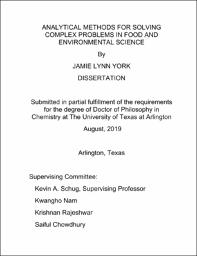| dc.description.abstract | Complex samples can be challenging for analysis in a number of different ways. Food and environmental samples can be particularly difficult due to their non-uniformity from sample to sample, possible unknown contents, and complexity in terms of their number of constituents and range of abundances of different species. To overcome challenges faced with the analysis of complex samples, intricate sample handling and processing techniques need to be tailored in order to build optimal methods. These procedures can include sample preparation techniques, on-line sample clean-up, and/or tools that the instrument has to offer. Each complex sample needs to be assessed for possible interferences with target analytes to determine the optimal way to proceed and if the interferences can be removed.
These studies focused on a combination of food and environmental samples where the focus and methods were customized to mitigate matrix interferences. Methods of analysis, such as LC-MS or GC-MS, and sample introduction techniques, such as headspace, were very instrumental in the success of each method. In the first study, coeluting isomers of dimethylnaphthalene were quantitatively deconvoluted into their respective concentrations using gas chromatography- vacuum ultraviolet (GC-VUV) and qualitatively detected in samples of diesel and jet fuel with the use of spectral filters. It was found that all the coeluting pairs of dimethylnaphthalene isomers could be accurately deconvoluted at ratios with a disparity of nearly two orders of magnitude in relative abundance (1:99). In the next project, a hydraulic fracturing additive used in unconventional oil and gas extraction, proppants, were examined to determine their propensity to leach formaldehyde at lab-simulated downhole conditions by the use of three different instruments: LC-UV, headspace GC-MS, and headspace GC-VUV, to determine the best method of analysis. It was found that under the lab-simulated subsurface conditions the proppant leached less formaldehyde, likely due to competing reactions in the matrix. The next complex sample included another hydraulic fracturing additive, friction reducers. These were qualitatively tested by matrix-assisted laser desorption/ionization for their ethoxylated alcohol content and their behavior at lab-simulated downhole conditions. It was found that upon heating and subjection to shale core and produced water, the ethoxylated alcohol content tended to polymerize or stay relatively the same average weight distribution, indicating that it is likely not breaking down once below the surface.
Carbohydrates were the next study, which were investigated by GC-VUV and samples that coeluted were deconvoluted. Pharmaceutical samples were then analyzed for their carbohydrate content using this previously developed method. Mixtures of carbohydrates that coeluted were deconvoluted to determine concentration of each compound. Finally, a method was developed to simultaneously determine hormones, mycotoxins, and fat-soluble vitamins in eggs. This was performed using an LC-MS/MS coupled with a RAM column for on-line sample removal of large biomolecule interferences. It was found that the hens diet had a great effect on the fat-soluble vitamin and mycotoxin content. Throughout all of these complex samples, various analytical methods, including multifarious sample preparation techniques, were used to retrieve reliable, accurate, and reproducible data. | |


